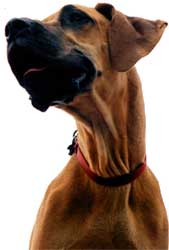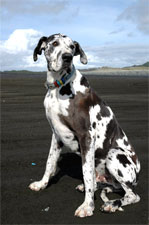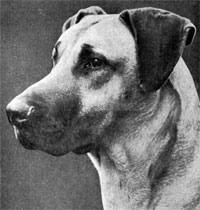|

 Guess who's taller : Height and weight requirements for show dogs vary from one kennel club's standards to another, but generally the minimum weight falls between 100 to 120 lb Guess who's taller : Height and weight requirements for show dogs vary from one kennel club's standards to another, but generally the minimum weight falls between 100 to 120 lb
and the minimum height must be between
28 and 32 inches at the withers. Most standards
do not specify a maximum height or weight.
In August 2004, a Great Dane named "Gibson" from Grass Valley, California was recognized by the Guinness Book of Records as the world's tallest dog, measuring 42.2 inches
at the withers.
A Coat of many colors : There are six show-acceptable coat colors for Great Danes: Fawn, Brindle, Blue, Black, Harlequin, and Mantle. Fawn is yellow gold with a black mask. Black should appear on the eye rims and eyebrows, and may appear on the ears and tail tip. Brindle is fawn and black in a chevron stripe pattern. Often also referred to as a tiger-stripe pattern. Blue is a pure steel blue. White markings at the chest and toes are not desirable. Black be a glossy black. White markings at the chest and toes are not desirable. Harlequin as a base color shall be pure white with black torn patches irregularly and well distributed over the entire body; a pure white neck is preferred. The black patches should never be large enough to give the appearance of a blanket, nor so small as to give a stippled or dappled effect. Eligible, but less desirable, are a few small gray patches, or a white base with single black hairs showing through, which tend to give a salt and pepper or dirty effect. And finally mantle, which shall be black and white with a solid black blanket extending over the body; black skull with white muzzle; white blaze is optional; whole white collar preferred; a white chest; white on part or whole of forelegs and hind legs; white tipped black tail. A small white marking in the black blanket is acceptable, as is a break in the white collar.
Other colors occur occasionally but are not acceptable in the show ring. Because they are not valid for show dogs, they are not pursued by breeders. These colors include white, fawnequin, merle, merlequin, fawn mantle, and others. These are sometimes advertised as "rare" colors to unsuspecting buyers. Any coat that includes "mouse gray" is disqualified from show.
Mr. Big-ears : Cropping of the ears is common in the United States and much less common in Europe. Indeed, in some European countries, in parts of Australia, and in New Zealand, the practice is banned, or controlled such that it may only be performed by veterinary surgeons for health reasons.

Man's Best Friend: The Great Dane must be spirited, courageous, always friendly and dependable, and never timid or aggressive. They are intelligent, strong dogs that are protective and loyal to their owners. Many are gentle and delicate, although not to the extent of being timid. They take to training well, make good watchdogs and are fairly low maintenance compared to many other breeds. Great Danes, like most giant dogs, have a fairly slow metabolism. This results in less energy and less food consumption per pound of dog than in small breeds.
 HealthWatch: Great Danes have some health problems that are common to large breeds. Bloat (a painful distending and twisting of the stomach) is a rare but critical condition that affects Great Danes and results rapidly in death if not quickly addressed. It is a commonly recommended practice for Great Danes to have their stomachs tacked (Gastropexy) to the interior rib lining during routine surgery such as spaying and neutering if the dog or its relatives have a history of bloat. Another problem common to the breed is in the hips (hip dysplasia). Typically an x-ray of the parents can certify whether their hips are healthy and can serve as a guideline for whether the animals should be bred and are likely to have healthy pups. HealthWatch: Great Danes have some health problems that are common to large breeds. Bloat (a painful distending and twisting of the stomach) is a rare but critical condition that affects Great Danes and results rapidly in death if not quickly addressed. It is a commonly recommended practice for Great Danes to have their stomachs tacked (Gastropexy) to the interior rib lining during routine surgery such as spaying and neutering if the dog or its relatives have a history of bloat. Another problem common to the breed is in the hips (hip dysplasia). Typically an x-ray of the parents can certify whether their hips are healthy and can serve as a guideline for whether the animals should be bred and are likely to have healthy pups.
Dilated cardiomyopathy (DCM) and many congenital heart diseases are also commonly found in the Great Dane. Also, some Danes may develop yeast infections, when not fed all needed nutritional requirements. The yeast infection may also lead to minor recurring staph infection(s).
Great Danes also suffer from several genetic disorders that are specific to the breed. For example, if a Great Dane lacks color (not white) near its eyes or ears then that organ does not develop and usually, the dog will be either blind or deaf.

 Grecian Gods: Often referred to as the "Apollo of Dogs", the Great Dane we know today is thought to have originated from larger German Bullenbeisser dogs. The Bullenbeisser was used in Germany for hunting large wild boar. Some texts about Great Danes say this breeding was accidental. There are also those who believe that the Great Dane was created by crossing a Greyhound with an English Mastiff. The origin of the "Dane" appellation is unclear; the breed almost certainly did not originate in Denmark, and indeed is still known in German as the Deutsche Dogge and in French as the Dogue Allemand, both meaning "German mastiff". Grecian Gods: Often referred to as the "Apollo of Dogs", the Great Dane we know today is thought to have originated from larger German Bullenbeisser dogs. The Bullenbeisser was used in Germany for hunting large wild boar. Some texts about Great Danes say this breeding was accidental. There are also those who believe that the Great Dane was created by crossing a Greyhound with an English Mastiff. The origin of the "Dane" appellation is unclear; the breed almost certainly did not originate in Denmark, and indeed is still known in German as the Deutsche Dogge and in French as the Dogue Allemand, both meaning "German mastiff".
All text is available under the terms
of the GNU Free Documentation License
|
